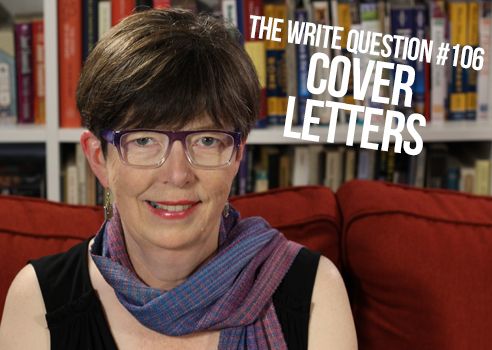Viewing time: 5 mins. 28 secs.
The Write Question is a weekly video podcast about writing that I started in 2017 and that ran, more or less weekly, until April 2022. This is a republication of issue #106, which gives advice on how to write better cover letters. The post first ran on Sept. 6/19.
Transcript:
Do you want to learn how to write better cover letters? That’s the topic I’ll be addressing today in The Write Question. I’m Daphne Gray-Grant, the Publication Coach.
I have a question from Tianying Wang, a postdoctoral research scientist based at Columbia University in New York. Here’s the recording of what she’s asked.
“I would like to know how to write an appropriate cover letter. I found it’s required everywhere such as for paper submissions and job applications. However, I don’t know how to write [them] exactly. For example, which rules should I follow? Does the cover letter in paper submissions differ from the cover letter for job applications? Or generally do I just need to state what’s included in the submission or do I need to include more details about the file I submitted? It would be great if you could help me answer these questions. Thank you very much.”
Thanks for the question, Tianying. You’re asking about two quite different cover letters here, so let me comment on them one at a time.
A cover letter for an article to a journal will help the editor decide whether to send your manuscript out for peer review.
To tackle this challenge, you should begin with a paragraph giving the name of the manuscript and the names of the authors. As well, describe the type of manuscript it is — for example, a research article, a case study, a review. Then, describe the rationale behind your study and the major findings from your research. Here, you can also refer to prior work that you’ve published, but only if it’s directly related.
Next, write a short paragraph that explains why your manuscript would be a good fit for that specific journal. This is probably the most important paragraph of the entire letter, so spend some time writing it. Don’t say something banal like your paper is “of interest to the field,” or predictable, like it’s “novel and ground-breaking.”
Instead, be really specific about why your paper is a good fit for that particular journal. To do this properly, you’ll need to have studied the journal carefully. You should also have looked at their Aims & Scope statement and their submission guidelines, which should be listed on their website.
Finally, close with a brief paragraph showing that the manuscript is original, that no part of it has been published before and that it is not being considered by any other journals. If you have any conflicts of interest, disclose them here. If not, say that you have none.
Do all of those jobs, and you’ll have written an excellent covering letter for a journal submission!
On the other hand, if you’re trying to write a cover letter for a job application, my recommendations are a little different.
A cover letter for a job should accompany each and every resume you send out. Employers use cover letters as a way to screen applicants for jobs and to determine which candidates they would like to interview.
A cover letter should complement, not duplicate, your resume. Its purpose is to interpret the data-oriented, factual resume and add a personal touch.
A cover letter is written in a letter format including a salutation — for example, Dear Dr. Wilson. Unlike a resume, use the first-person — I — and the letter should be short, only three or four paragraphs.
The purpose of a job-seeking cover letter is to highlight your qualifications and help the employer interpret the background you’ve given. A resume states facts; a cover letter adds colour and personality. It should persuade employers you’re a good fit for the job.
More than a resume, a cover letter allows you to convey subjective information, such as your interest in a position, how your values motivate you, or why the culture of a company appeals to you. Keep in mind that this letter needs to be much more than bullet points pulled from your resume. It’s a unique document.
I’ve included a link below with a before and after version of a cover letter. I think you’ll find it quite instructive in terms of how to add a personal touch.
While the two types of cover letters you’ve mentioned are fundamentally different, Tianying, keep in mind that they have one thing in common. Both are meant to be persuasive. And in order to do that you need to show some of your personality, not just facts.
Finally, let me wrap up with a quote from American businesswoman Sophia Amoruso: “When I go through hundreds of applications from people who all have very similar-sounding experience, cover letters are the only glimpse I have into a person’s personality.”
Tianying, the vast majority of people don’t write terribly compelling cover letters. If you can dedicate some time to learn how to write better cover letters, you’ll be giving yourself a tremendous advantage over your competition.
Links
Fast Company article from someone who reads cover letters


